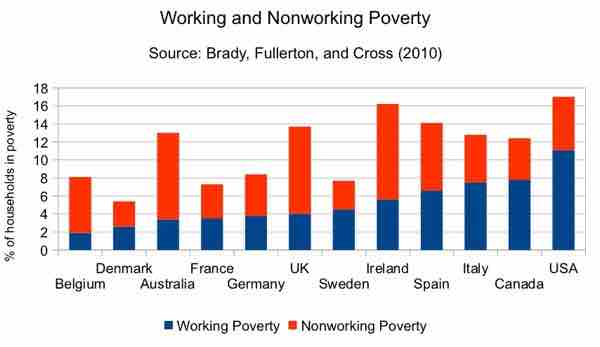Introduction
The working poor are working people whose incomes fall below a given poverty line. Conversely, the nonworking poor are unemployed people whose incomes fall below a given poverty line . The main difference between the working and the nonworking poor, liberal policymakers argue, is that the nonworking poor have a more difficult time overcoming basic barriers to entry into the labor market, such as arranging for affordable childcare, finding housing near potential jobs, or arranging for transportation to and from work. In order to help the nonworking poor gain entry into the labor market, liberal scholars advocate that the government should provide more housing assistance, childcare, and other kinds of aid to poor families.

The Working Poor
Percentage of the working and nonworking poor in different countries
Distinctions
Since the start of the War on Poverty in the 1960s, scholars and policymakers on both ends of the political spectrum have paid an increasing amount of attention to tackling poverty. One of the key ongoing debates concerns the distinction between the working and the nonworking poor. Many conservative scholars tend to see nonworking poverty as a more urgent problem than working poverty because they believe that non-work is a moral hazard that leads to welfare dependency and laziness, whereas work, even poorly paid work, is morally beneficial. On the other hand, liberal scholars and policymakers often argue that most working and nonworking poor people are quite similar.
Many of the policies that have been proposed to alleviate the obstacles that working poor people face may also be applied to the nonworking poor. These policies include: welfare state generosity, including unemployment and child benefits; increased wages and benefits, which may have a positive effect on unskilled workers who are likely to be among the nonworking poor; increased vocational education and training for the same demographic; child support assurance, especially for families headed by a single parent; and increased rates of marriage, although a lack of good employment opportunities may not lower the poverty rate among low-income people.
Obstacles to uplift
The working poor face many of the same everyday struggles as the nonworking poor, but they also face some unique obstacles. Some studies, many of them qualitative, provide detailed insights into the obstacles that hinder workers' ability to find jobs, keep jobs, and make ends meet. Some of the most common struggles faced by the working poor are finding affordable housing, arranging transportation to and from work, buying basic necessities, arranging childcare, having unpredictable work schedules, juggling two or more jobs, and coping with low-status work.
Housing
Working poor people who do not have friends or relatives with whom they can live often find themselves unable to rent an apartment of their own. Although the working poor are employed at least some of the time, they often find it difficult to save enough money for a deposit on a rental property. As a result, many working poor people end up in living situations that are actually more costly than a month-to-month rental.
Transportation
Given the fact that many working poor people do not own a car or cannot afford to drive their car, where they live can significantly limit where they are able to work, and vice versa. Given the fact that public transportation in many US cities is sparse, expensive, or non-existent, this is a particularly salient obstacle.
Basic Necessities
Like the unemployed poor, the working poor struggle to pay for basic necessities like food, clothing, housing, and transportation. In some cases, however, the working poor's basic expenses can be higher than the unemployed poor's. For instance, the working poor's clothing expenses may be higher than the unemployed poor's because they must purchase specific clothes or uniforms for their jobs.
Childcare
Working poor parents with young children, especially single parents, face significantly more childcare-related obstacles than other people. Oftentimes, childcare costs can exceed a low-wage earners' income, making work, especially in a job with no potential for advancement, an economically illogical activity. However, some single parents are able to rely on their social networks to provide free or below-market-cost childcare. There are also some free childcare options provided by the government, such as the Head Start Program. However, these free options are only available during certain hours, which may limit parents' ability to take jobs that require late-night shifts.